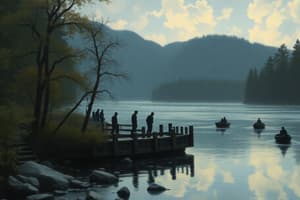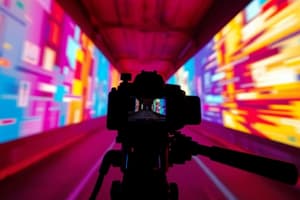Podcast
Questions and Answers
A close-up shot is used to capture the overall setting of the film.
A close-up shot is used to capture the overall setting of the film.
False (B)
Cinematographers do not usually consider how each scene is shot.
Cinematographers do not usually consider how each scene is shot.
False (B)
The medium shot captures the subject at a close range to capture minute details.
The medium shot captures the subject at a close range to capture minute details.
False (B)
The long shot is used to frame a character's face in order for the audience to see their emotions.
The long shot is used to frame a character's face in order for the audience to see their emotions.
The variance of camera angles in filmmaking is not used to enhance the narrative, the theme, and the overall mood of the film.
The variance of camera angles in filmmaking is not used to enhance the narrative, the theme, and the overall mood of the film.
There are four different types of basic camera shots.
There are four different types of basic camera shots.
Basic camera shots refer to the indication of subject size within the frame.
Basic camera shots refer to the indication of subject size within the frame.
Advanced camera shots are not used in filmmaking.
Advanced camera shots are not used in filmmaking.
The close-up shot is usually used to reveal details or information about objects or the setting of the film.
The close-up shot is usually used to reveal details or information about objects or the setting of the film.
A medium shot is captured at a close distance from the subject.
A medium shot is captured at a close distance from the subject.
The medium shot allows the viewer to have a solid view of each character within a film.
The medium shot allows the viewer to have a solid view of each character within a film.
The long shot is often used as an establishing shot in a film.
The long shot is often used as an establishing shot in a film.
A long shot shows only the full length of the subject without including the surrounding area of the film setting.
A long shot shows only the full length of the subject without including the surrounding area of the film setting.
The long shot can create a sense of separation between the film and the audience if used solely from a distance.
The long shot can create a sense of separation between the film and the audience if used solely from a distance.
The medium shot is known as the 'sweet spot' shot because it allows for both the details of the subject and the surrounding setting to be seen.
The medium shot is known as the 'sweet spot' shot because it allows for both the details of the subject and the surrounding setting to be seen.
The long shot is also known as the close-up shot.
The long shot is also known as the close-up shot.
A long shot is often used to capture establishing scenes in movies.
A long shot is often used to capture establishing scenes in movies.
A medium shot is not suitable for capturing the body language of characters in a film.
A medium shot is not suitable for capturing the body language of characters in a film.
Flashcards
Close-up shot's purpose
Close-up shot's purpose
Close-up shots reveal details and information about objects or the setting.
Medium shot
Medium shot
A shot showing a character's body from mid-chest up, good for subject and surroundings.
Long shot's use in film
Long shot's use in film
Establishes setting, distance.
Long shot vs close-up
Long shot vs close-up
Long shot is a distant, full view; close-up is detailed and zoomed in. They're opposites.
Signup and view all the flashcards
Medium shot function
Medium shot function
Shows characters and surroundings well, body language.
Signup and view all the flashcards
Long shot and separation
Long shot and separation
A long shot can create separation between the audience and the action.
Signup and view all the flashcards
Close-up role
Close-up role
Reveals character emotions and details.
Signup and view all the flashcards
Medium shot capturing
Medium shot capturing
Captures a character within the context of their surroundings.
Signup and view all the flashcards
Long shot function (establishing)
Long shot function (establishing)
Sets the scene's context or location.
Signup and view all the flashcards
Long shot: Full length?
Long shot: Full length?
A long shot includes more than just the subject's full body.
Signup and view all the flashcards
Close-up shot validity
Close-up shot validity
A close-up captures overall scene settings.
Signup and view all the flashcards
Medium shot's 'sweet spot'
Medium shot's 'sweet spot'
Balanced view of subject and surrounding context.
Signup and view all the flashcards
Medium shot body language
Medium shot body language
A medium shot allows for capturing and showing the body language of a person in the film.
Signup and view all the flashcards
Long shot vs. Establishing shot
Long shot vs. Establishing shot
Long shot establishes the setting; it's an establishing shot.
Signup and view all the flashcards
Basic camera shots
Basic camera shots
Basic camera shots indicate the size of the subject within the frame.
Signup and view all the flashcards
Medium vs. close range shot
Medium vs. close range shot
Medium shot isn't a close-range view, it's a middle or standard distance to the subject.
Signup and view all the flashcards
Cinematographers' consideration of scenes
Cinematographers' consideration of scenes
Cinematographers consider how each shot contributes to the film's narrative.
Signup and view all the flashcardsStudy Notes
Camera Shots in Filmmaking
- A close-up shot is used to reveal details or information about objects or the setting of the film, not to capture the overall setting.
- There are four different types of basic camera shots, which refer to the indication of subject size within the frame.
- The medium shot captures the subject at a moderate distance, providing a solid view of each character and allowing for both the details of the subject and the surrounding setting to be seen.
- The medium shot is considered the 'sweet spot' shot because it offers a balance between the subject and the setting.
- A long shot, also used as an establishing shot, shows the full length of the subject, but may create a sense of separation between the film and the audience if used solely from a distance.
- The long shot is often used to capture establishing scenes in movies, but it is not suitable for capturing the body language of characters.
- The variance of camera angles in filmmaking is used to enhance the narrative, the theme, and the overall mood of the film.
Studying That Suits You
Use AI to generate personalized quizzes and flashcards to suit your learning preferences.




